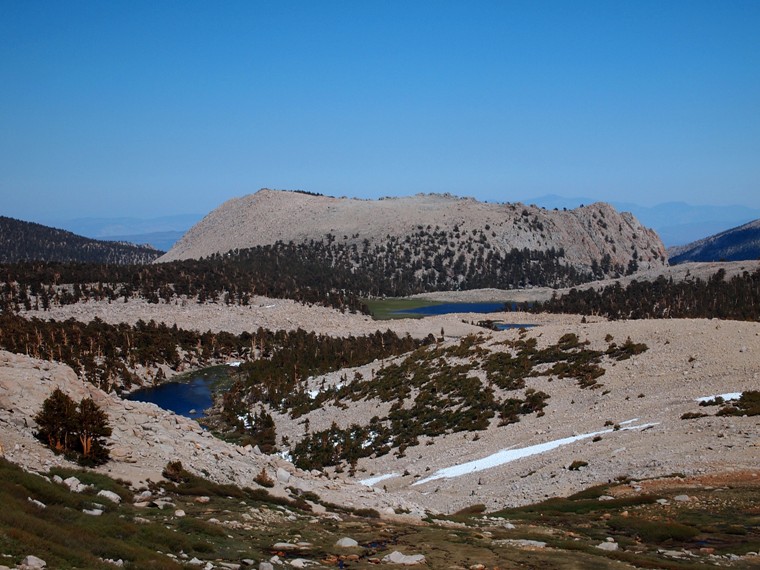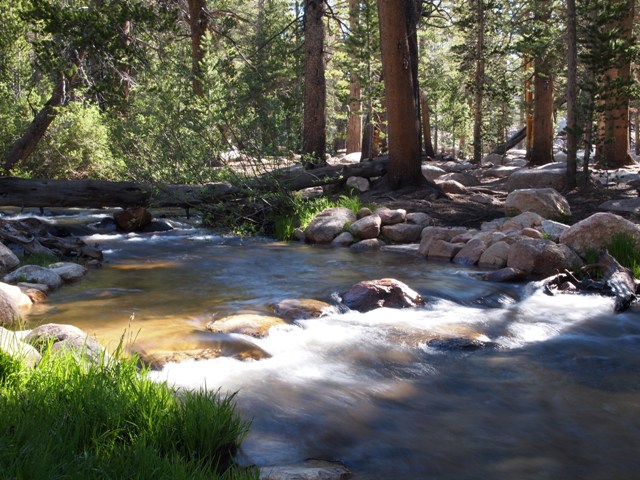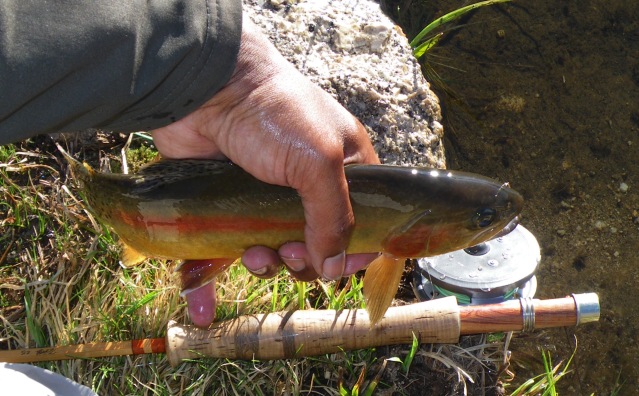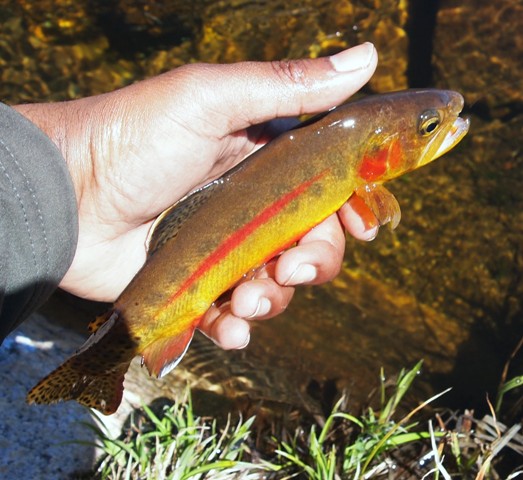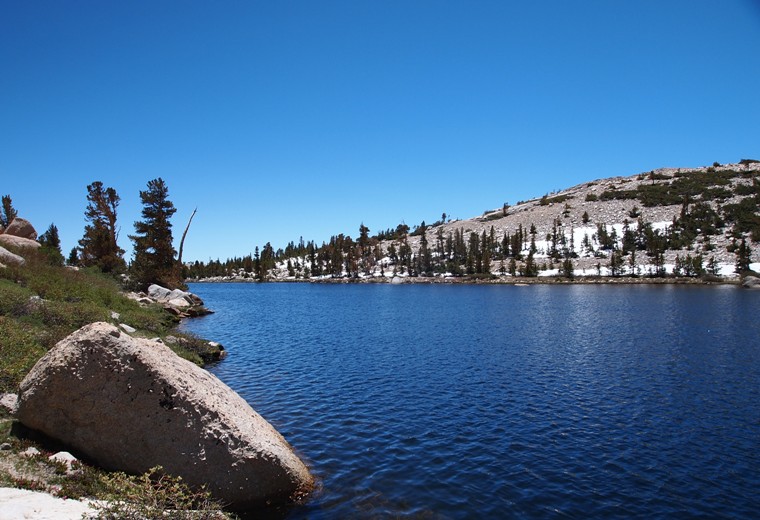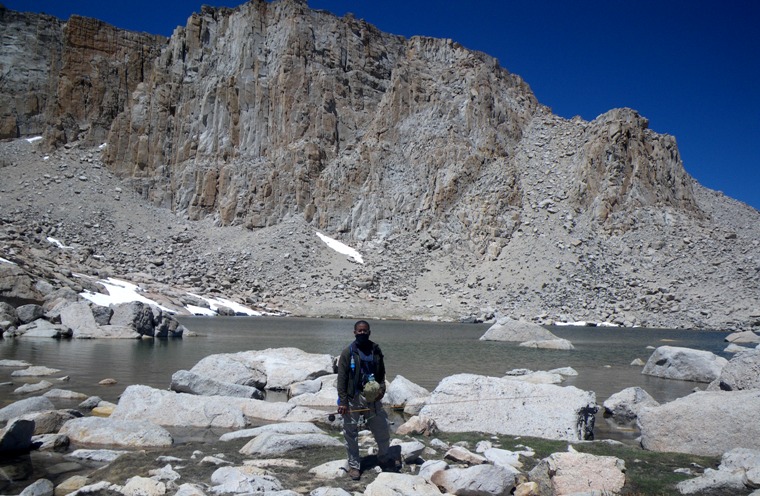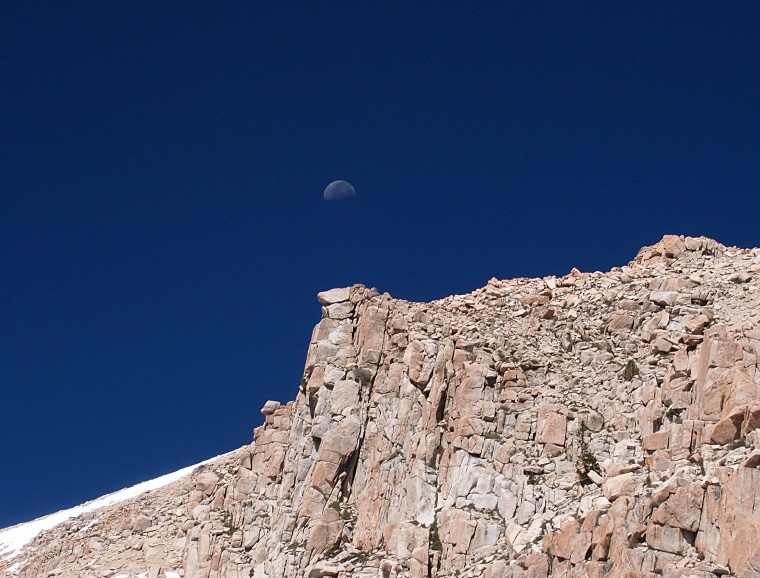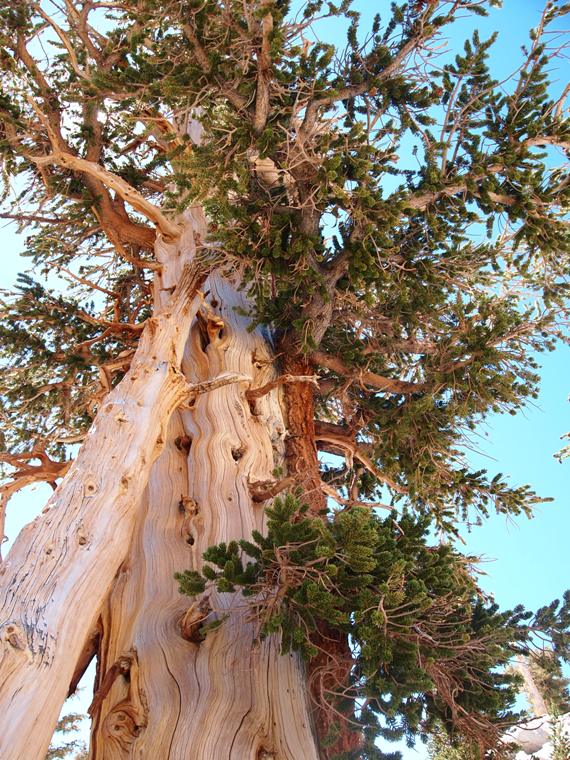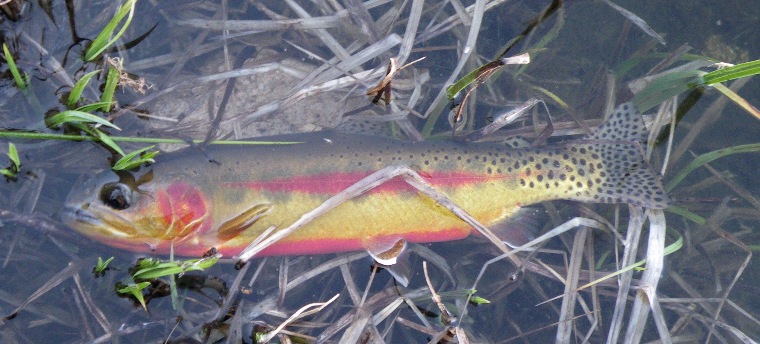|
|
|
|
|
July 1 to July 3, 2010 Cottonwood Lakes Basin
Time:
Narrative: I’ve completed my quest to visit all of the fish baring lakes in the Cottonwood Lakes area. I still haven’t fished them all, I haven’t fished lakes 1 and 2 and I guess I still haven’t visited lake 6 but lake 6 is almost a myth. Can it even be called a lake? Does it even hold fish? Who knows? I say “quest” but if I was really so eager to visit all the lakes I would have done so soon after that first day of fishing Cottonwood Creek 10 years ago. I guess it’s been more of a gradual pursuit than a quest. There are still areas to fish but the draw is less so than it used to be. I have a definite favorite lake in the watershed and I’m drawn to it time and time again- sometimes to fish, sometimes to just say “hello” as I return from fishing other waters.
When I come here I almost don’t see the need to visit other lakes. It’s not an “epic” lake by any standard. Cottonwood #1 and #5 routinely give up bigger fish. Cottonwood #3 probably has more fish. Cottonwood #4 and #5 are arguably in a more beautiful basin and one could argue that Cottonwood #2 sees fewer visitors but there’s something about the combination of fishing, scenery and solitude that draw me back to this one particular lake. Despite the visits since my solo backpacking trip in 2002, this year is the first that I’ve camped at the lake. It’s been in the plan for many years, most notably last year when I became ill right at the trailhead, but it’s simply never happened until now and may never happen again. This lake so satisfies me as a fly fisher that after several hours of fishing it the first day, I could have returned to my car perfectly satisfied and eminently fulfilled. In fact, the extra days I spent there almost seemed forced. I don’t have a need to catch numbers of fish and the handful of 12 to 13 inch fish I caught sight fishing the first day were enough. The additional fish I caught sight fishing that day were icing on the cake and the additional fish I’d catch prospecting the next two days just made a great experience all the more interesting. There were other reasons to spend 3 days at the lake, like the camaraderie of friends and the chance to do some exploring beyond what is usually possible in a day trip.
The lakes in the Cottonwood Creek watershed officially opened for the season on July 1st and so, 3 days after traveling to the Eastern Sierra to fish the Hilton Lakes, I was again heading down HWY 395 late in the evening. I arrived at the trailhead to an empty parking lot and took up my “usual” parking/sleeping spot next to the Golden Trout interpretive display. The empty lot was in stark contrast to the 60 people each day that would be entering at the trailhead over the next 3 or 4 days. The Cottonwood Lakes is not the only place one can catch golden trout, it’s not even the first place open to golden trout fishing during the season, but it does have a plethora of “alternate” Golden Trout waters available and sees more than its fair share of users on the opening weekend. Since 2006, something has always come up to scuttle my trip to these lakes on this particular weekend- either illness, or work, or a family emergency and this year I was determined to do everything in my power to ensure that didn’t happen. Illness- I took a tablet of Airborne every morning and made sure not to eat strange foods. Work- well the company is moving to Hong Kong and I’m not- ‘nuff said there. Family Emergency- that’s not within my control but everyone seemed happy and healthy coming into this Independence Day weekend. I slept for 3 hours before daybreak, probably not long enough to adequately acclimatize to the additional 10,000 feet of elevation gain but it was enough to feel somewhat rested as I took my time compiling my gear. I hit the trail about 8am and was fishing the lake by 11:30am. I spent a ridiculously long time choosing my camp site. I was first on the lake and hemmed and hawed about were to camp. I tend to do this, trying to stay clear of falling trees or branches, running water or too much wind. I had passed two fellows fishing the creek just before the big bluff but by the time I had finished setting up camp, they were set up and on the water. “The fish are taking size 18 and 16 parachute Adams”, they both eagerly told me. Thank you very much but sometimes what you fish is almost as important as how you fish and just as I planned to cast to only fish I could spot, starting off fishing a Parachute Adams almost seemed to easy. Sure it worked, but it didn’t garner quite the reaction in the fish that I was hoping for. What reaction is that? The reaction that has them breaking their normal feeding or cruising pattern and slamming the fly. That "have to have it" reaction that a black ant usually causes. The black ant didn’t have its usual mojo. The fish charged the fly and then turned away at the very last second, often causing a slight wake when doing so. I did catch one nice fish on an ant but found very early that Thursday that the fish couldn’t refuse a well placed gold ribbed hares ear. At least they couldn’t on this day, as the week progressed they seemed to be “on” to the hares ear and it became harder and harder to convince the fish to accept it without hesitation. After setting up camp I wandered down to the rock were I hooked into a “I can’t believe this fish is about to spool me” sized golden a few years earlier. I casually sat on the rock and ate and strung up my rod as I’d do for each morning thereafter. I watched the fish as they rose to midges and cruised the shallows. Fly Fisherman Magazine Southwest Board regular SoCal Bob would observe later that the fish over the weeds seemed to be looking up and those over the silty mud flats would be looking down. This makes sense if you had emerging midges and a wind that would blow them out deeper into the lake, which is what we had. I also observed that the fish only seemed to be interested on one of the midges. There were two, male and female and they were mating but the fish only seemed to be interested in the one. I can’t remember which one but they were slightly different colors and different sizes. The mating pairs were all over the place, on the rocks, in the bushes. I quickly ran through my 6 or so standard high country patterns and decided that a size 18 hares ear was the ticket. Almost as fun and a bit more difficult than fishing a dry fly to sighted fish is fishing a nymph to sighted fish. I’d stand on the rock, watching the fish cruise by and when I spotted a fish 10 plus inches in size I’d make the cast. No motion was given to the fly, it would just slowly sink. The fish would turn and I’d have to watch and judge when the fish had actually taken the fly. In some cases this was easy, as the fly was clearly visible; in other cases, especially with longer casts, I’d have to wait for a clue such as the fish turning its head. For the first few hours on Thursday morning the action was fast and furious. SoCal Bob and the guys from the Fly Addicts board showed up just as things started to slow. I say “slow” but it was more like all the fish cruising the area had been hooked or pricked by my hares ear and the jig was up. I knew some of the guys, Bob, Mark and Ryan, from the Southwest Board of Fly Fisherman Magazine. We’d spend sometime fishing together but mostly had our own agendas. One of the most fun parts of the trip was spotting fish for Mark and another fellow the morning I left. Mark was standing on the rock and several of us were perched just below my camp site were we could pretty clearly see most of the fish within a casting distance of about 60 feet. We narrated, spotted the big fish for the guys, cheered when they caught fish, gave each other a good ribbing, it was great fun. A special thank you has to go out to Ryan who, when it was my turn on the rock, waded into waste deep water to free a fish that had tangled in the weeds. “It would be perfect if you could free the fish AND retrieve my fly” I said. This generated a great roar of laughter and comments from the guys.
After the guys arrived, I decided to put on my waders and work the weed bed. I’d work my fly from the drop of to the edge of the weeds in a fan pattern. It was here that I landed a fish that I’d been trying to catch earlier from the rock. It was distinguishable by a spot at the top of its head. I had pricked it on a dry fly and gave it a long distance release from the hares ear. I was fishing an Ant with a hares ear dropper about a foot from the weeds when the water around the ant exploded. It turned out that the fish had taken both flies. I wasn’t willing to wade too deeply in the weeds. I didn’t have a wading staff and each step was carefully taken to avoid falling into deeper water. On the far side of the lake, in an area that usually provides good fishing. I spotted and hooked a good fish. Unfortunately, the water was deep and I wasn’t close enough to the edge to release it, so I induced a LDR. It was at this point that I gave up fishing the weed line and started fishing the inlet stream. Fishing on the stream was fast and furious. I followed it down to where it entered the lake and fish were active and stacked up. I could clearly see the fish and they apparently were not disturbed by my presence so I decided to do a little experimentation. I threw all sorts of bugs at them to watch their reactions. Flies I don’t normally fish but that might imitate the very small midges that they were freely feeding on, attractor flies and flies in the "I'm just curious" category. An RS2 fly of the proper size and color- no joy. A big Klinkhammer with it’s body well under the water- no joy. That ridiculously small sprout emerger thingy with the foam dot of a post- no joy. A parachute Adams, “yeah we’ll take that but we’re really not as excited about it as you think.” My cripple caddis- “interesting looking bug, but no, we’re really not interested.” A Sierra Bright Dot- “hey we really like this thing if we see it land. We’re not so interested if it’s been hanging around a bit.” Orange Parachute fly that I bought on the Savage River in Maryland and don’t remember what it represents- “bring it on!” Various nymphs- “did something hit the water, that we should care about?!?” It was an interesting and fun experiment
but I eventually waded back to shore and continued around the lake sight
fishing with the hares ear.
The next morning while eating grape pop-tarts on the rock and stringing up my rod, a 12 inch trout swam by working about a 6 inches off the bank. I made one cast and landed the fish. I was basically done on this lake for the day. I caught a few more fish before working my way up the water shed but noticed that there didn’t seem to be as many cruising fish as the day before. My goal Friday was to fish Long Lake. I’ve always wanted to visit Long Lake. My website is relatively old, 12 years as of this writing but during the early days on the internet I remember coming across another site, which was well established at that point and discussed Golden Trout fishing at Long Lake. I can't find the site now. I'm sure it's out there but with so many references to Golden Trout these days, it's hard to find but "back in the day" it was one of the first pages to appear in a web search on Golden Trout. At that time I’d only heard of the Cottonwood Lakes and so I was intrigued by Long Lake. I’ve never made the hike through the basin to this lake until now.
Long Lake is just that, a longish lake in the shape of a squash- a wide shallow flat on the outlet side, with a long middle ending in a bulbous inlet area. There wasn’t much going on at Long Lake. There were a few fish working but I walked around the entire lake and made few casts. There just weren’t many fish worth casting to and you could spend all day prospecting in a lake like that. Instead, I decided to look for active fish and eventually turned up the trail to New Army Pass to fish High Lake. High Lake would have been a challenge to fish if the fish were actually interested in feeding but they weren’t. A third of the shoreline was still covered by "deepish" snow, a second third was comprised of large boulders and brush and looked inaccessible and the last 3rd was on the far side of the lake and would require traversing the first two. At High Lake the fish were in a spawning mood and hanging in the gavel shallows of the inlet. Those fish that weren’t spawning were swimming around like zombies. They didn’t feed and didn’t spook and seemed undisturbed by any actions I’d take, stealthy or otherwise. Still it was a thrill just to finally fish these two lakes and I had a most excellent day culminating in two memorable fish on the way back to camp. I’d really been playing with fish for most of this trip and as I made my way down the outlet creek from Long Lake, that hadn’t changed. I’d identified the Sierra Bright Dot as an irresistible pattern on the other lake and under the right conditions and on a whim, I put one on. I really haven’t fished the pattern much since the afternoon in 2002 I spent on Cottonwood #3.
Walking down the trail I spotted a run on the creek that was too nice to pass up. I made a few casts, one of which resulted in a text book drift and a fishy response. It’s the small things that matter and seeing that Sierra Bright Dot dancing on the water, floating down the run was immensely satisfying. Especially so because it probably caught the big fish of the pool… or so I thought. A few steps down the trail a snow bank still hung over the creek. It was about 3 or 4 feet wide and another 3 feet high. The water was clearly visible below but not the bank. I couldn’t tell where the edge started so from the safety of solid, snow covered ground, I peered into the small chute. I could see a nice fish working a small toilet bowl sized run. I dropped the Sierra Bright Dot onto the water and it raced over the fishes head with just slightest reaction twitch from the fish. I decided to switch to my bead head hares ear. The bead head hares ear was a Golden Trout away from a Sierra Grand Slam. In the past it has caught Rainbows, Brown Trout, it absolutely decimated the Brook Trout at Hilton Lakes, it garnered fast action from big Cutthroat Trout near Tahoe and today would complete the slam by adding a Golden Trout to its palmares. (A cycling term which is French for list of achievements.)
I dropped the nymph into the water. At first it whizzed by the fish and the trout showed little interest. The fish was pretty actively feeding and it became apparent to me that it was only feeding on items coming from the current tongue on the right; it was ignoring items coming from the main current. I dropped the fly to it’s right and the fish tried to grab it as it shot by. Several more passes and hot dog! I was into a good fish! I’m betting the fish would have gone at least 14 inches if I could have measured it. It was a large, with a thick, bright yellow body and thin red stripe….and I had no way to land it. I was in a similar predicament as the weed bed. I couldn’t walk to the edge without collapsing the snow bank and I didn’t want to drag it up or downstream to somewhere I could land it. Another LDR was in order. Back at camp, I fished my way around the lake back to the rock. I was soon joined by Justin, one of the Addict guys and a new comer to these lakes. There wasn’t much going on in the sight fishing department so I joined Justin in a fun evening of prospecting. We targeted specific fish or rises when we could and cast for distance and stripped the flies quickly back to shore when we couldn’t. The evening before the fish had gone bonkers and Justin had done quite well, landing some bigger from what I understand. This night they were a little more subdued. Interestingly, there was less wind on the water and perhaps the fish didn’t feel as safe as they do under a slightly riffled surface. We had a blast. Whether we cast to a sighted fish or not, when the fish were “on” our flies they’d follow the quickly moving bugs for a distance and either turn away at the last instance or grab the fly. We could see their bright orange, red and yellow bodies creating a wake just under the surface. On the hook up the surface would often erupt violently, signaling the protest of the thrashing fish. That night, with the wind down, the mosquitoes were out in force. I’d picked up one of those new repellant “shields” currently being offered by Off and found it didn’t work or at least didn’t work well. In fact, I found a dead mosquito in the fan mechanism, so much for its repelling qualities. I pulled out my deet but was quickly put off by the smell. I never did find out if it was the deet or the sunscreen or the combination of both that I turned out to be allergic to last year but the mere smell of the deet brought it all back to me. I retired to my tent early that night. It had been pretty warm at night but in anticipation of very cold weather I’d been sleeping with a mylar “emergency” blanket. The blankets are said to reflect 90% of body heat but what they don’t tell you is that they also collect quite a bit of condensation. I woke in the middle of the night with my sleeping bag drenched in condensation and wondered if the emergency blanket meant to keep me warm was going to now result in hypothermia. It was a good experience. I suspect in the wrong survival situation, this tendency to condense vapor could prove deadly. Fortunately, I have a synthetic and not down sleeping bag and kept warm through out the night despite the dampness. Synthetic materials insulate when wet, down doesn’t and that’s why I’ve always carried a synthetic bag. Down is lighter but when I crawl into a sleeping bag, wet or dry I want to stay warm. That morning I again ate my breakfast on the rock. The cruising fish seemed fewer yet again and I don’t think I made a single cast until some of the others showed up. I hiked up to Cirque Lake to see if it was truly “dead” as I’d heard. It looked like a great fishing lake but had no spawning area and no doubt the fish simply died out. I gave my campsite to a brother and sister team that had arrived shortly before I’d left for Cirque Lake and when I returned to pick up my pack, shared some of my Hot Creek flies for when they planned to fish Hot Creek later in week. I hope the flies served them well. I’d said my good byes to the addict guys earlier in the day and as I left camp that last time, only SoCal Bob was on the water. With my full pack on, I walked down the lake hoping to catch one last fish before heading down the trail. Several strong takes with immediate LDRs was all I was granted. I said my good byes to Bob and ambled down the trail.
Previous Golden Trout Wilderness chronicle Next Golden Trout Wilderness chronicle Chronicle Index
|

